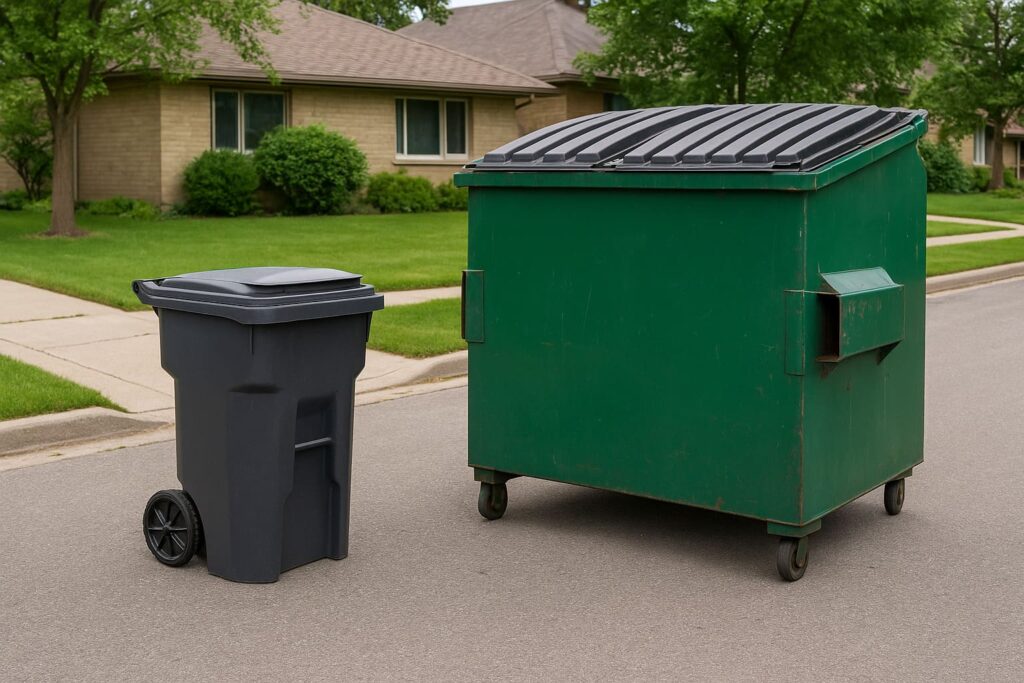Choosing between garbage carts vs bins matters more than it sounds. It affects safety, sanitation, recycling success, and the frequency of calls for help (either by you or your contractor). In Winnipeg, homeowners balance city curbside cart rules with the convenience and capacity of private bins for cleanouts, renovations, and yard work. This guide walks through the real trade-offs, local rules, environmental context, and practical advice so you can pick the right system for your home and projects. I’ll include local references, useful examples, and, when it makes sense to bring Mr. Garbage into the picture.
Garbage Carts vs Bins: Definitions and where each is used
Start with plain language.
- Garbage cart: a wheeled, lidded container provided by municipal or private curbside services for regular residential collection. In Winnipeg, curbside carts are the standard for weekly collection. They’re designed for automated or semi-automated lifting and routine service. City of Winnipeg
- Bin: a private bin (also called a dumpster or roll-off) is larger, usually temporary, and used for short-term projects like renovations, yard cleanups, or bulky-item removal. Bins come in sizes and types that suit construction debris, bulky furniture, or mixed loads.
The question isn’t which is “better” overall; it’s which fits your needs. Both systems have strengths and weaknesses depending on volume, frequency, access, and diversion goals.
Garbage Carts vs Bins: Advantages of garbage carts
Garbage carts win for routine residential life. Key benefits:
- Regular, predictable pickups. City collection is scheduled; you don’t manage trips to depots. Winnipeg asks residents to place carts at the curb by 7 a.m. on collection day. City of Winnipeg
- Automation and safety. Wheeled garbage carts and automated arm systems reduce heavy lifting and injuries for residents and crews.
- Better seasonal management. For households with normal weekly waste patterns, carts keep the street tidy and reduce illegal dumping.
- Integration with recycling and organics. Where municipal programs exist, carts form the backbone of curbside diversion and contamination control.
For everyday trash, carts are the low-effort, low-risk choice, especially for seniors or households that prefer an unattended weekly routine.
Advantages of bins
Bins are a sensible tool for non-routine work. They’re often preferred when:
- Volume spikes: Renovations, large cleanouts, and landscaping projects produce sudden, bulky debris that won’t fit in carts.
- Material separation is needed: Bins allow you to stage a small on-site sorting area — metal, clean wood, drywall — before pickup.
- Short-term control: A bin stays in place while the job proceeds. It prevents debris from spilling onto sidewalks or street corners.
- Accessibility for crews: Contractors can load a bin from the driveway or loading area without moving materials around the property.
A well-managed bin keeps a site safer and cleaner during intense project phases. For many homeowners, the ideal plan uses both carts for routine waste and a bin for the project window.
Accessibility and physical constraints
Practical constraints matter.
- Carts are limited by doorways, stairs, and resident strength. They’re designed to move smoothly to the curb but aren’t meant for bulk debris or heavy renovation loads. Wheeled garbage cart benefits show up for everyday use: they reduce repeated lifting and the strain on backs and shoulders.
- Bins need truck access and placement space. If your driveway is narrow or you’re on a tight inner-city lot, delivery and pickup logistics matter. Additionally, if a bin sits on the boulevard or street, Winnipeg requires permits for right-of-way or street use — check before delivery. City of Winnipeg
If access is tight, plan placement carefully with your hauler before ordering a bin. Mr. Garbage will advise on vehicle approach and whether a bin can sit fully on private property (usually simpler) or needs a permit (when public space is used).
Contamination, recycling, and diversion effects
This is the part people underestimate.
- Carts encourage a steady diversion habit because municipalities align collection with recycling and organics programs. Consistent weekly pickup helps capture recyclables from households. Environment and Climate Change Canada shows residential sources deliver a large share of diverted solid waste in Canada — household behaviour matters. Canada
- Bins can be great for diversion if you use them for separated streams. But they’re often used for mixed loads. A mixed bin full of drywall, soiled wood, and contaminated materials reduces the chance of recycling and can increase landfill tonnage.
Small on-site separation, metal, clean wood, cardboard, changes everything. For example, putting scrap metal aside for recycling before filling the bin means the bin carries less recyclable value and the metal gets processed correctly. If you plan a bin for a home project, decide early which materials you’ll separate and which will go mixed.
Safety, pests, and weather
Each system needs reasonable care:
- Carts with lids keep animals and rain out. Winnipeg’s cart carts are designed to close securely so wind and animals don’t scatter garbage. Regular users report fewer vermin issues when lids are kept closed and food waste is bagged.
- Bins, especially open-top roll-offs, can attract scavengers and wildlife if left uncovered. In windy weather, lightweight items can blow out. Use covered or lockable bins in neighbourhoods where scavenging or weather is a concern. Secure tarps and lids prevent loads from spilling during pickup, which is also a municipal safety consideration.
On hot days, bagging wet food and scheduling a pickup sooner reduces odour problems. Mr. Garbage offers covered bin options and advice on securing loads to reduce these risks.
Rules, permits, and local logistics
Local rules shape the choice.
- Cart rules: Winnipeg’s curbside carts have clear expectations. Set your carts out by 7 a.m. on collection day and follow size/placement rules. Missed collection reporting is available if the cart isn’t emptied by evening. City of Winnipeg
- Bin rules: If a bin sits on public property (street or boulevard), you’ll likely need a city permit. Private-property placements are simpler, but always check condominium or neighbourhood rules before delivery. Also, some facilities accept certain materials only when sorted; putting banned items in a bin can result in rejected loads.
If in doubt, ask the hauler about permit responsibilities and depot acceptance. Mr. Garbage advises Winnipeg homeowners on whether the bin will trigger a permit and helps route material to the correct facilities.
Environmental context and why the choice matters
This is where your decision affects more than your driveway.
- National surveys show Canadians diverted nearly ten million tonnes of waste from landfill in recent years, but there’s still a long road ahead. Properly managed residential programs contribute substantially to diversion. Statistics Canada and federal indicators show residential sources are responsible for a significant share of diverted and disposed waste. Better sorting from curbside carts and responsible bin use both help. www150.statcan.gc.ca
- A homeowner who uses carts for weekly waste and uses a bin for separated renovation debris (metal, clean wood, drywall) helps feed local recyclers with higher-quality material. That small separation step produces measurable results at scale.
Cost, convenience, and the hidden trade-offs
You didn’t ask for numbers, and you won’t get them here. But there are trade-offs to consider:
- Convenience vs control: Carts are convenient and require less thinking. Bins give control over volume and handling for short-term needs.
- Frequency vs capacity: Carts limit capacity but encourage frequent, light disposal. Bins handle one-time bulky volume.
- Diversion potential: Carts linked to municipal recycling programs help ongoing diversion. Bins can support diversion, but only if you plan separation.
In practice, many Winnipeg homeowners use both carts for everyday life and bins for spikes. If you expect repeated project demands, plan recurring short-term rentals or staged pickups, your hauler can help.
How homeowners use both systems
Example 1: A family doing a bathroom and kitchen update used carts weekly for routine household rubbish and booked a small bin for the demo week. They set aside metal fixtures and a pile of clean lumber at the side to be picked up separately for recycling. The hauler staged a pickup after demo day, and the rest was taken as mixed C&D to an appropriate processor.
Example 2: A senior homeowner prefers not to manage yard waste. They rely entirely on curbside carts and municipal seasonal pickups. The predictable cart schedule and tidy lids reduce physical strain and neighbour complaints.
Both approaches work; the trick is matching the tool to the job.
Practical moments to outsource
You’ll want a local partner when:
- You have a one-time bulky cleanout and don’t want multiple depot trips.
- You need a bin for a renovation and want guidance on permits and routing.
- You want documentation that materials were sent to certified processors (useful for permits or resale).
- You want help separating streams to maximize recycling and reduce landfill.
Mr. Garbage offers both bin rental and local pickup services, plus advice on the most effective way to combine carts and bins for your situation.
Quick checklist for choosing one
Ask yourself:
- Is this routine weekly disposal or a one-off project? (If routine → cart; if project → bin.)
- Do I need to separate recyclables or hazardous items? (If yes → plan separation and ask hauler.)
- Is driveway space and truck access available for a bin? (If no → consider staged smaller bins or additional cart pickups.)
- Do I want documented routing to processors? (If yes → use a hauler that provides receipts.)
Answer these and you’ll pick the system that actually works for your life.
Conclusion
Garbage carts vs bins isn’t an either/or argument. For many Winnipeg homeowners, the best arrangement is both carts for predictable, low-effort weekly service; bins for projects and spikes. Thoughtful on-site separation and working with a local hauler increases recycling and reduces avoidable trips to the landfill.
If you want hands-on help planning this, a simple site check and a staged bin plan, Mr. Garbage works with Winnipeg homeowners to match carts and bins to real needs, arrange permits if required, and route materials responsibly. One practical plan, less hassle, better diversion.
Unsure whether a cart or a bin fits your next project? Contact Mr. Garbage for a brief assessment and a clear, practical recommendation tailored to your Winnipeg home.
Frequently Asked Questions (FAQs)
Q1: What’s the main difference between garbage carts and bins?
A1: Garbage carts are wheeled containers used for regular curbside collection. Bins (dumpsters or roll-offs) are larger, temporary containers used for short-term projects like renovations or cleanouts.
Q2: Do I need a permit to place a bin in front of my Winnipeg house?
A2: If the bin occupies public space (boulevard, sidewalk, or street), the City of Winnipeg typically requires a right-of-way or street-use permit. If it sits entirely on private property, permits are usually not required. Check local rules before delivery.
Q3: Can bins help with recycling, or do they just go to the landfill?
A3: Bins can support recycling if you separate streams on-site (metal, clean wood, cardboard). Mixed bins are less likely to be recycled. Plan separation and discuss routing with your hauler to maximize diversion.
Q4: Which is safer for seniors, a garbage cart or a bin?
A4: Garbage carts are usually safer for seniors because they’re designed for wheeled transport and reduce heavy lifting. Bins are better for large projects but require lifting and handling that may not be senior-friendly.
Q5: When should I call Mr. Garbage for help?
A5: Call Mr. Garbage for bin rental guidance, permit advice, staged pickup planning, or when you want documented routing to certified processors for renovation or cleanout work.

